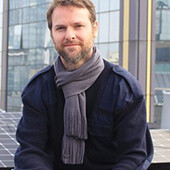World Wide Fund for Nature published "The Energy Report" recently (in partnership with Ecofys consultants), outlining how the world can reach 100 percent renewable energy by 2050. I corresponded with Jean-Philippe Denruyter, WWF's manager for Global Renewable Energy Policy, about the policies and technologies that will make this possible.
Evan O'Neil: Your new report calls for 100 percent renewable energy by mid century. Why not sooner? Futurist Ray Kurzweil recently commented that if we extrapolate from the growth rate in solar installations there will be enough renewable energy to power the world 20 years from now.
Jean-Philippe Denruyter: Sooner would be even better!
But unfortunately solar panels will not cover all our energy needs, at least if we consider current technologies—they will provide electricity but will not deliver fuels. Maybe in the future there will be "solar" hydrogen, produced for instance through electrolysis, but in the meantime we will still need other, non-solar technologies to provide energy-dense liquid and solid fuels, such as biomass. These may be more difficult to disseminate at such a fast pace.
Reaching 100 percent renewable electricity will be relatively easy, even if we increase electricity use to "electrify" society, but the more difficult part will be finding alternatives to meet the remaining need for liquid and solid fuels. Even a huge growth in solar will not enable us to achieve 100 percent renewable energy on its own.
Still, solar growth is impressive today, that's true. But it will be difficult to sustain such growth over the next decades. Growth of installed capacity compares to the amount of MW already installed. Since this installed capacity is increasing over time, maintaining similar growth of over 50 percent a year will be more and more difficult. Yet we hope for the best!
Of course, such growth will only be possible if policies continue supporting solar. This support has unfortunately been variable of late in the United States and the European Union. We need consistent and long-term policies that will bring us as soon as possible to solar electricity prices that are competitive with fossil fuels and nuclear. And believe me, we are not that far away anymore.
EO: What are the policy innovations you'd like to see and the policy limitations we must overcome?
JPD: We need policy innovations across the board. Here are just a few.
Some policies have already proved effective and authorities desiring to promote renewable energy would do well to learn from them. In the field of renewable energy, feed-in tariffs that are well managed (with financial support decreasing to match decreasing technology costs) have been most efficient economically and in terms of installed capacity. Here the challenge is to ensure continuity over time. Other measures need to accompany these support schemes in order to bring down barriers preventing renewables growth.
For a full list of such measures, I recommend one of our recent publications, "Heliosthana." Heliosthana is an imaginary island in the middle of the Mediterranean Sea that has gone through a whole series of changes in order to improve its energy mix.
One should not forget the people who don't have access to electricity or who still depend on traditional biomass for their energy needs. They also have the right to renewable energy sources that are socially and environmentally sound. Policy innovations in this sector are often still lacking, while technologies to improve those people's conditions do exist and are becoming cheaper and better. Policies creating a stable market for sustainable renewable energy and efficiency technologies could make a huge difference.
EO: Speaking of energy efficiency, is it the lowest of the low-hanging fruit?
JPD: Energy efficiency has huge potential and has unfortunately suffered from a lack of coherent policies. Slowly, some governments have enacted policies to increase efficiency in housing, industry, services, transport, and appliances. Another example is the phaseout of incandescent light bulbs in various parts of the world. But in order to tap the full energy efficiency potential, we will need to go much further.
A systematic policy approach to increase efficiency incrementally in all these sectors is paramount. This can be a clever portfolio of existing policies in different countries: a Japanese top-runner approach for appliances, a British target to make all new houses "passive energy" before 2020, an EU policy (beefed up) to reduce energy consumption per km in transport, a Japanese train system, a Tunisian solar hot water scheme.
We also need more supportive policies to improve public transport and incentivize people to use it, plus better electricity grids to absorb more renewable electricity.
And of course, clever financial mechanisms are required to make these innovations affordable and interesting for people. In the end, everybody has to gain from energy efficiency. It's a simple question of long-term benefits (reduced operating costs) versus short-term higher expenses (higher capital expenditure) that needs to be resolved, with interesting loans, third-party investors, etc.
EO: Some commentators have warned that the "Paradox of Efficiency" won't incentivize an overall decline in consumption or pollution. Do you believe there is a real effect here? How should we react to it?
JPD: The paradox of efficiency should not be neglected. However, we know that people's behavior is very often influenced by costs and access to information and education. If tomorrow all cars become twice as efficient as today, more people may be tempted to buy SUVs. But if tomorrow all cars become twice as efficient and public transport is drastically improved, a special tax on SUVs makes them relatively more expensive, the price of energy is doubled, and information channels explain how much better it is for your future and your children's future to use public transport, then I don't think the positive effect of efficient vehicles will be canceled out by a surge in SUV sales.
EO: With an urban revolution underway, many people tout green cities as the thing that will save us, but can cities be extracted from our larger relationship to the land?
JPD: Better city planning will become more and more important. We need to be more efficient in the way we travel to work—public transport, cycling, and walking need to be more attractive to people, cities need to be greener and compact. That's a long-term but crucial exercise.
The sustainability of renewable energy sources, and especially bioenergy and hydropower, needs to be followed closely. Standards and certification systems do exist (for example, the Roundtable on Sustainable Biofuels, and the Hydropower Sustainability Assessment Protocol) but these standards need to be strengthened and empowered through policy. Standards alone are not sufficient. They fail to properly address impacts beyond the power station or the farm gate. Hence, governments need to carefully plan renewable energy production, as well as land and water use, in order to mitigate cumulative impacts.
And then there is the elephant in the room: "human" efficiency. If there is one sector where policy innovation is lacking, that's it. We waste huge quantities of food, from field to fork (and even after the fork, when we throw away what we have not eaten; see, for instance, Tristram Stuart's book Waste). And we feed ourselves in a completely inefficient way. Meat is land, energy, and greenhouse gas intensive compared to vegetables, grains, and vegetable protein. This should be reflected in food pricing. Hamburgers in the United States would be much more expensive if corn weren't subsidized the way it is.
EO: What are the best ways you've outlined for developing countries to leapfrog directly to clean energy and improve energy access?
JPD: A combination of measures is required for developing countries to fully embrace clean energy technologies. Here are a few.
Fossil fuel subsidies are a huge barrier to clean energy development (renewables and efficiency). Subsidies can come in many different ways. For example, oil is bought by the government and sold back to the national electricity company and to fuel distributors at a lower price. This not only weighs heavily on public budgets (sometimes energy subsidies exceed 15–20 percent of public budgets) but also makes it nearly impossible for clean energy to access the market. Subsidy reforms that include compensation plans for the poorest are the main solution. With increasing fossil fuel prices and energy consumption, developing countries will have to think of alternatives quickly.
Other barriers to clean energy must also be removed (again, see "Heliosthana" for more details): import taxes on renewable energy technologies, a lack of skilled labor forces, no clean energy branch in energy ministries, and no energy agencies capable of supporting the sector.
Parallel to this is support for innovative businesses. More and more clean energy technologies are making their way to the market, for cooking, lighting, heating, and electricity production. These options can be more expensive in the short term than traditional sources, but again in the long term they are financially interesting. By creating an enabling climate for such businesses, while developing appropriate financial schemes (such as microcredit and credit guarantees), it seems that the moment is now ripe to disseminate new solutions rapidly.
This can only happen where people are part of the solution. For example, a lot of people make a living in the forestry and charcoal business, yet this does not mean they love to cut forests and travel further everyday to find biomass. Provide them with alternatives, such as sustainable plantations, better carbonization techniques, efficient cookstoves, and solar stoves, and they will be the promoters of the new solutions.
EO: Climate agreements are down at #10 on the report's list of priorities, perhaps implying that they are too big to ignore yet too cumbersome to succeed. What are they best suited to achieve?
JPD: There is no real hierarchy between the ten recommendations. Maybe climate agreements are less in the spotlight because "The Energy Report" is really focused on energy solutions.
It is true that today, countries compete in the field of renewables because they believe that fossil fuels are finite and energy dependence is dangerous. That could suffice to grow renewables to a reasonable share of the energy mix. But will this guarantee a phaseout of coal? Will this guarantee that we leave unconventional fossil fuels in the ground? Probably not. There is no guarantee that clean energy will solve our climate problem without a higher, common goal.
There needs to be a global framework that goes beyond market and geopolitical realities in order for countries to work toward a global and common solution to climate change. If national interests are the only driver, we will not achieve our 100 percent renewables vision.
EO: The price of oil is rising astronomically again. Does this affect your 2050 outlook?
JPD: It only makes our vision "easier" to achieve. Ecofys used fossil fuel price projections from the IEA in our scenario. The world is way above those projections right now. If the trend continues, the economic benefits of our vision will be much greater, and the financial attractiveness of renewable energy and energy efficiency will be even higher. But let us see how fossil fuel prices evolve over time, beyond the current "Arab Spring," and including, unfortunately, the further development of unconventional fossil fuels.
EO: Which renewable industries will be the biggest winners? Is geothermal a dark horse in the running?
JPD: The Ecofys scenario shows wind and solar technologies are the biggest winners. But the choice to favor some technologies should not necessarily be seen as the future reality. It could be that wind plays a greater role than solar, or solar a greater role than wind, depending on technology and cost developments, or even social considerations.
However, it is true that some resources are more local, such as geothermal electricity, and hence cannot be used everywhere with current technologies. Other resources are limited as well, such as biomass. These technologies are certainly not "losers," just less universal than wind and solar.





